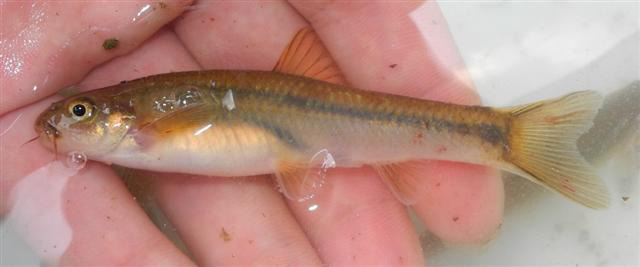|
Vertebrae: 39-40. Diagnosis: Elongate body, somewhat compressed with a midlateral dark stripe. Last unbranched dorsal fin-ray soft and smooth posteriorly, with distal margin truncate. Axillary scale present at base of pelvic fin. Complete lateral line running along midline of caudal peduncle; with 38-40 perforated scales. Subterminal mouth with lower jaw covered with thick horny sheath. No notch on upper jaw or no symphyseal knob on lower jaw. Vomeropalatine organ in roof of mouth absent. Epibranchial organ at top of gill cavity absent. Two pairs of well-developed barbels. A shallow depression run along the median portion of the upper lip (Ref. 53787).
Description: Elongate body slightly compressed with greatest body depth immediately in advance of dorsal-fin origin; least depth of caudal peduncle closer to caudal-fin base than to posterior end of anal-fin base. Ventral profile from snout tip to posterior end of anal-fin base convex, from posterior end of anal-fin base to caudal fin base slightly concave or straight. Head is small with its length less than body depth. The snout is blunt with length greater than eye diameter, without tubercle on tip, and laterally with a shallow groove extending along the anteroventral margin of lachrymal to corner of mouth. The eye is positioned dorsolaterally in anterior half of head and interorbital space wide and somewhat convex. Mouth subterminal, wide and arched; maxillary ascending process not extending to vertical through anterior edge of eye. Rostral fold simple, only covering base of upper lip. Upper lip fully adnate to upper jaw, a shallow depression running along median portion, continuous with lower lip at corner of mouth. Lower lip separated from the lower jaw by a shallow groove running along entire lower jaw, with a postlabial groove interrupted medially. Lower jaw covered with a thick horny sheath but without a sharp margin. Well-developed barbels; the rostral pair at anterior end of shallow groove extending along the anteroventral margin of lachrymal, its length less than eye diameter and maxillary pair at corner of mouth, its length greater than eye diameter. Scales moderately sized, apical field greatly elongated with large number of converging posterior radii. Lateral line with perforated scales 35 - 37, plus three on caudal-fin base. Predorsal scales 14 - 16, regularly arranged. Chest no scales; belly scaled and scales slightly smaller midventrally. One or two scales between vent and anal-fin origin. Dorsal fin with 4 unbranched and 7 or 8 branched rays, last one split to base; last unbranched ray soft and smooth posteriorly; distal margin truncate; origin slightly in advance of pelvic-fin origin. Pectoral fin with 1 unbranched and 12 or 13 branched rays, not reaching halfway to pelvic fin origin. Pelvic fin with 1 unbranched and 8 branched rays, reaching beyond halfway to anal-fin origin. Anal fin with 3 unbranched and 5 branched rays, last one split to base; distal margin truncate; origin midway between pelvic-fin origin and caudal-fin base. Forked caudal fin with upper and lower lobes equal in length and shape, pointed tips. Vertebrae 24 + 15 = 39, 25 + 15 = 40, 24 + 16 = 40. Pharyngeal teeth in three rows, 5, 3, 2/2, 3, 5 (3), with pointed, somewhat curved and compressed tips. Air bladder bipartite; anterior chamber oval or round; posterior chamber oblong and twice as long as anterior chamber. Gill rakers small and sparse. Color in formalin: body grayish dorsally, lighter ventrally. A midlateral dark stripe originating at upper extremity of gill opening and terminating at caudal-fin base, running along first scale row above lateral line in advance of vertical through posterior end of dorsal-fin base and then along midline of caudal peduncle, getting slightly wider and more prominent along posterior half of body. All fins grayish (Ref. 53787). |

